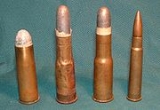
.577 Snider
Encyclopedia
The .577 Snider cartridge
was a British
black powder metallic cartridge, which fired a .577" 480gr lead projectile, primarily used in the Snider-Enfield
rifle.
Early .577 Snider cartridges were made from paper, with a metallic base and primer, but later commercial cartridges were made from drawn brass, much like modern small arms
ammunition. The .577 Snider cartridge was eventually replaced in service by the .577/450 Martini-Henry
cartridge in the 1870s. The .577 Snider cartridge is considered obsolete, with commercial production having ceased in the 1930s.
Cartridge (firearms)
A cartridge, also called a round, packages the bullet, gunpowder and primer into a single metallic case precisely made to fit the firing chamber of a firearm. The primer is a small charge of impact-sensitive chemical that may be located at the center of the case head or at its rim . Electrically...
was a British
United Kingdom
The United Kingdom of Great Britain and Northern IrelandIn the United Kingdom and Dependencies, other languages have been officially recognised as legitimate autochthonous languages under the European Charter for Regional or Minority Languages...
black powder metallic cartridge, which fired a .577" 480gr lead projectile, primarily used in the Snider-Enfield
Snider-Enfield
The British .577 Snider-Enfield was a type of breech loading rifle. The firearm action was invented by the American Jacob Snider, and the Snider-Enfield was one of the most widely used of the Snider varieties. It was adopted by British Army as a conversion system for its ubiquitous Pattern 1853...
rifle.
Early .577 Snider cartridges were made from paper, with a metallic base and primer, but later commercial cartridges were made from drawn brass, much like modern small arms
Small arms
Small arms is a term of art used by armed forces to denote infantry weapons an individual soldier may carry. The description is usually limited to revolvers, pistols, submachine guns, carbines, assault rifles, battle rifles, multiple barrel firearms, sniper rifles, squad automatic weapons, light...
ammunition. The .577 Snider cartridge was eventually replaced in service by the .577/450 Martini-Henry
.577/450 Martini-Henry
The .577/450 Martini-Henry was a black powder, centerfire round used by the British and British Empire militaries prior to the adoption of the .303 calibre cartridge used in the Lee-Metford, Martini-Enfield, and Lee-Enfield series of rifles alongside the Nepalese Bira gun...
cartridge in the 1870s. The .577 Snider cartridge is considered obsolete, with commercial production having ceased in the 1930s.

